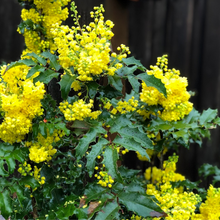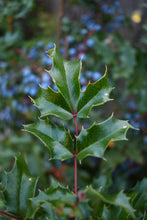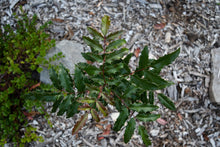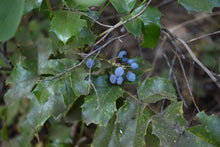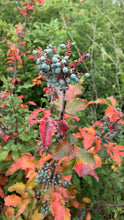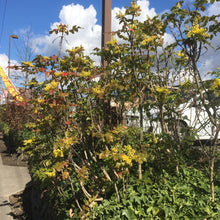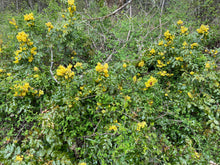
Mahonia aquifolium / Berberis aquifolium
Tall Oregon grape is as beautiful as it is versatile; offering dynamic year round appeal for the gardener while being extremely beneficial to wildlife. It’s a large evergreen shrub with pointy, holly-like leaves that emerge a bronzy coppery color, then mature to a deep, glossy green and eventually put on a show of reds, oranges and even purples in extreme conditions. In early spring, clusters of lightly fragrant, sunny-yellow flowers beckon mason bees from their cocoons. By summer, flowers ripen into dusty-blue berries adored by backyard birds.
- Plant type/canopy layer: evergreen, perennial, large shrub
- Size at maturity: 5-15' tall, 2-8' wide
- Light requirements: full sun, part sun/part shade, full shade
- Moisture requirements: dry to moist soil, prefers well-drained
- Bloom time: March - June
- Growth rate/ease: medium growth rate, easy to grow
- Wildlife support: flowers attract and provide nectar for hummingbirds, adult butterflies, bees and other insect pollinators; berries are eaten by many species of backyard birds such as robins, towhees and waxwings, as well as mammals; overall plant attracts and supports beneficial and other pest eating insects and is a larval host plant for native butterflies and moths including the brown elfin
- Native habitat/range: commonly grows in open woods and shrublands, from sea level to 1500m, across the Pacific Northwest from British Columbia in the north throughout California to the south and east into Montana and Idaho. Portland Plant List - yes.
- Special features & uses: hummingbird favorite; evergreen; drought tolerant; deer resistant; medicinally used in many ways including the stems and roots as a tea or tincture to support liver function; small purplish-black fruits are edible but quite tart/bitter and contain large seeds - best to sweeten in a jelly especially in combination with salal berries; inner bark of the larger stems and roots can be used as yellow dye; foliage sometimes used by florists in arrangements; landscape uses include erosion control, bank and slope stabilization, habitat hedgerows, pollinator gardens and woodland garden edges
Gardening with Tall Oregon Grape: This tall evergreen shrub is ideal for low-maintenance plantings such as woodland borders, habitat hedgerows, and erosion control on tough slopes. It thrives in a wide range of light and soil conditions, with a slight preference for partial shade and acidic, low-nutrient soil that is well-drained. That said, it can be exceptionally drought tolerant, rarely or never requiring supplemental water once established. With more sun, its form will be more compact and dense and it will also produce more flowers and berries for insects and wildlife. With more shade, it will grow a more open or leggy form with less flowers and berries - but it might be just the thing to fill those tricky dry, shady gaps in the foreground of your woodland garden.
It can spread slowly by rhizomes. If unwelcomed, simply remove unwanted suckers. It can be sheared into a hedge if desired, or pruned into a more upright form, ideally in the dry season to avoid infection.
This species grows well in the canopy of Douglas fir (Pseudotsuga menziesii) and Ponderosa pine (Pinus ponderosa) and many others and/or companion planted with wild ginger (Asarum caudatum), native fleabanes (Erigeron spp.), yarrow (Achillea millefolia), larkspurs (Delphiniums spp), Iris species (Iris spp), Penstemon species (Penstemon spp), Buttercups (Ranunculus spp) and checkermallows (Sidalcea spp).
Photo Credits 1 - 3: Tara Lemezis
Photo Credit 4: Nikkie West, Sparrowhawk Native Plants
Photo Credit 5: © eebee, some rights reserved (CC-BY)
Photo Credit 6: © Harry Podschwit, some rights reserved (CC-BY)
Photo Credit 7: © Lindsey K. Wise, some rights reserved (CC-BY)







